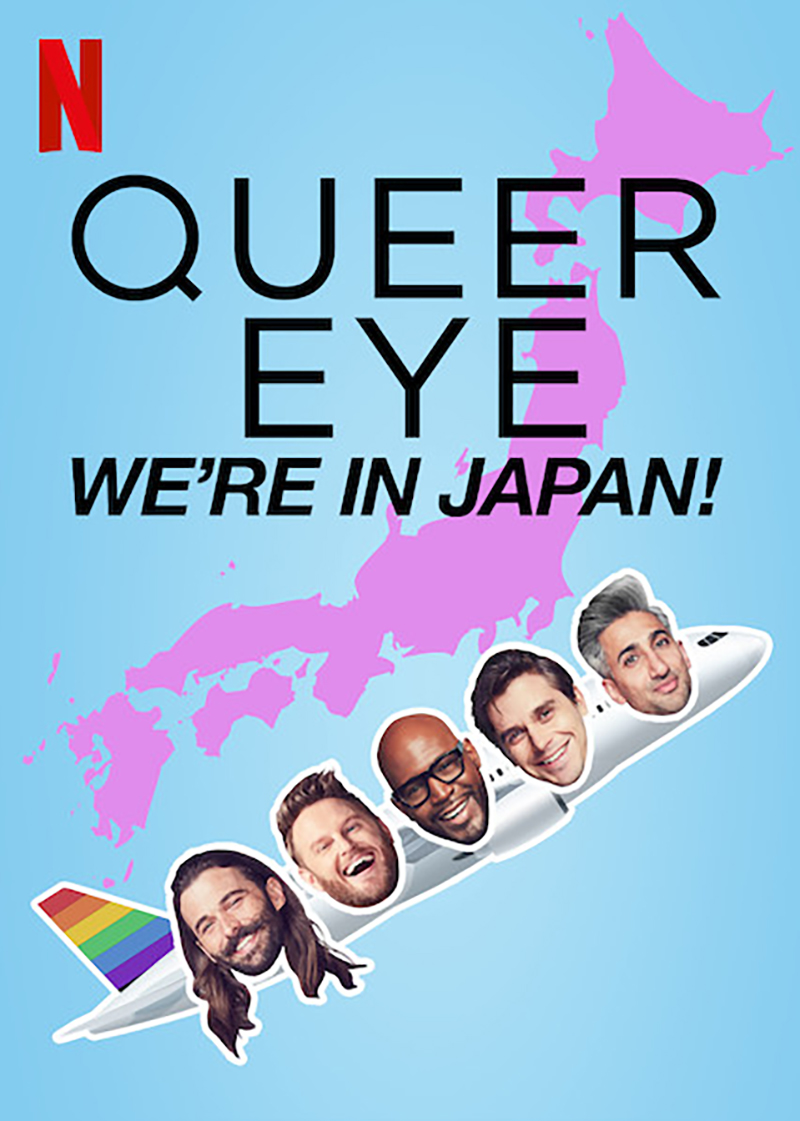Queer Eye, a Netflix reality TV series, released a new mini-series, *Queer Eye: We’re in Japan, on Nov. 1. Queer Eye is Netflix’s reboot of Queer Eye for the Straight Guy, which originally aired from 2003 to 2007.
Queer Eye is a make-over show staring five gay men (the Fab Five) who are each experts in their respective fields. Their aim is to transform the lives of their “heroes,” the people who are getting the make-over.
It is one of the unique shows on Netflix that truly gets better with every season. In this mini-series, the Fab Five go to Japan to revitalize the lives of two men and two women with the assistance of local guides, Kiko Mizuhara, a Japanese-American model, and Naomi Watanabe, a Japanese comedian. The mini-series also features an appearance by Kodo Nishimura, a Japanese Buddhist-monk and makeup artist.
Let me introduce you to the Fab Five. Antoni Porowski is a chef, originally from Québec, who helps heroes learn a new dish they can easily recreate on their own. Tan France is an English fashion designer who helps each hero buy a new wardrobe. Jonathan Van Ness is a hairdresser who transforms the heroes’ grooming routines and gives them each a stunning haircut. Karamo Brown is an activist and former social worker whose title on the show is “culture expert” who assumes the role of a therapist to the heroes, digging deep into their traumas and focusing on transforming their hearts and minds. Finally, Bobby Berk, the show’s true superstar, is an interior designer who renovates each hero’s home. I will admit that I sometimes watch Queer Eye just to see the home renovations; he truly shines in this mini-series with the added limitation of transforming tiny rental apartments in Tokyo.
Unlike the original series where the make-overs were only done on straight men, Queer Eye works with a diverse range of heroes. The We’re in Japan series starts with a middle-aged hospice nurse, Yoko Sakuma, who has dedicated her life, and her home, to ensure terminally ill patients finish their lives comfortably. One thing I love about Queer Eye is that it digs into a hero’s history, making each episode feel genuine and heartfelt. Sakuma dedicates her whole life to her work because she has regretted how her sister died in a hospital instead of in the comfort of her own home.
To maintain her selfless devotion Sakuma has “given up on being a woman” — a common idea in Japan that Mizuhara explains as women being pressured by how they have to look and, in response, making fun of themselves by saying they’ve given up on femininity. While working with The Fab Five, they discover her love for Audrey Hepburn, especially in Roman Holiday, and try to channel that energy in her new wardrobe, hair style, and home decor. My favourite moment in the whole series is in this episode, when Porowski takes Sakuma on a date to teach her how to make an apple pie. When the pie is done baking, the two take turns feeding each other dessert, and Sakuma even puts her hands on his hips as he feeds her, causing Porowski to burst out laughing; the scene cuts away to the two slow dancing in the kitchen together.
The final episode stars Makoto Chiba, who wants to change “from a rock to a psychedelic flower.” This shy radio director hopes to rekindle the romance and healthy line of communication between him and his wife of seven years, Yasuko. Their relationship resembles roommates rather than lovers. Makoto admits that their relationship has been sexless for five years, and the couple barely admit to one another that they love each other. Makoto and his wife have an emotional release where Yasuko admits that she has always feared that he regrets marrying her because she’s not a wife who cooks or does housework, to which Makoto replies: “I am saved by the fact that you exist.”
Queer Eye: We’re in Japan does a spectacular job of navigating Japanese culture with Mizuhara explaining cultural nuances, and is careful not to bulldoze over their heroes’ lives with American idealism. The show brought only 11 staff members to Japan. The rest of the crew were Japanese in order to make the heroes feel comfortable in front of the camera. The cast handles tough topics like homophobia, sexless marriages, and beauty standards without lumping the entire country into a stereotype.
Queer Eye brings the world a much-needed makeover show that transforms people from the inside out, focusing on self-love and self-care rather than merely on outward appearances. It’s great for viewers who need a good cry, a funny pick-me-up, or a motivational speech that will inspire them to get their life together.
Andrea Sadowski is working towards her BA in Global Development Studies, with a minor in anthropology and Mennonite studies. When she's not sitting in front of her computer, Andrea enjoys climbing mountains, sleeping outside, cooking delicious plant-based food, talking to animals, and dismantling the patriarchy.


